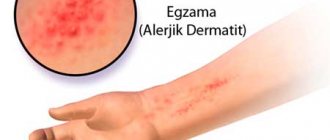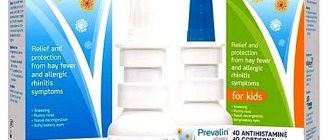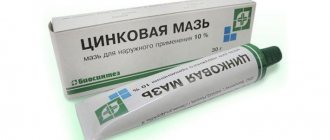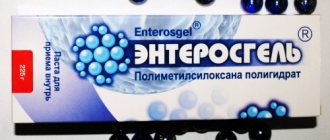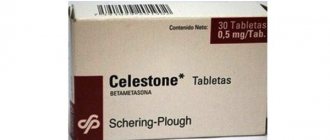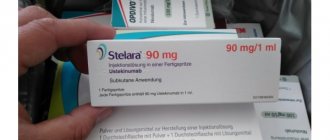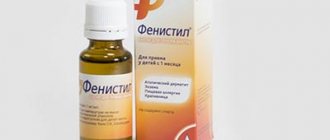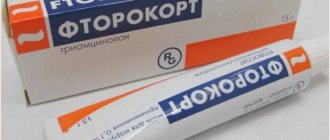What is Pantogam used for? Instructions for use, price and reviews
In this medical article you can familiarize yourself with the drug Pantogam.
The instructions for use will explain in what cases you can take syrup or tablets, what the medicine helps with, what are the indications for use, contraindications and side effects. The annotation presents the forms of release of the drug and its composition. In the article, doctors and consumers can only leave real reviews about Pantogam, from which one can find out whether the medicine has helped in the treatment of cerebral palsy and encephalopathies in adults and children (including infants and newborns), for which it is also prescribed. The instructions list analogues of Pantogam, prices of the drug in pharmacies, as well as its use during pregnancy.
Pantogam is a nootropic and anticonvulsant drug. Instructions for use recommend taking tablets 250 mg and 500 mg, capsules 200 mg and 300 mg active, syrup 10% for children and adults for neurotic disorders, schizophrenia, cognitive disorders, decreased mental and physical performance.
Release form and composition
Pantogam is produced in the following dosage forms:
- Tablets 250 mg and 500 mg.
- Capsules 200 mg and 300 mg Pantogam Active.
- Syrup 10%.
The active substance is the calcium salt of hopantenic acid.
pharmachologic effect
Pantogam is a nootropic drug. Its spectrum of action is associated with the presence of gamma-aminobutyric acid (GABA) in its structure. The mechanism of action is due to the direct effect of the drug on the GABAB receptor-channel complex.
The drug increases the brain's resistance to hypoxia and the effects of toxic substances, stimulates anabolic processes in neurons, has an anticonvulsant effect, and reduces motor excitability. Pantogam combines a moderate sedative effect with a mild stimulating effect.
What is the effectiveness?
increases mental and physical performance. helps normalize gaba metabolism during chronic alcohol intoxication and subsequent withdrawal of ethanol (alcohol).
inhibits acetylation reactions involved in the mechanisms of inactivation of novocaine and sulfonamides, thereby prolonging the action of the latter.
causes inhibition of the pathologically increased bladder reflex and detrusor tone.
pantogam is quickly absorbed from the gastrointestinal tract. the highest concentrations are created in the liver, kidneys, stomach wall, and skin. penetrates through the geb. not metabolized. excreted unchanged within 48 hours. 67.5% of the dose taken is excreted by the kidneys, 28.5% in feces.
Why is Pantogam prescribed?
Indications for use of the drug include:
- cerebrovascular insufficiency as a result of atherosclerotic pathologies of cerebral vessels;
- psycho-emotional overload;
- cognitive disorders as a result of organic brain pathologies;
- urinary disorders that are neurogenic in nature (urinary incontinence, pollakiuria, enuresis, urgency);
- forms of epilepsy, which are accompanied by a decrease in the reactivity of mental processes (with the combined use of anticonvulsants);
- decreased mental and physical performance;
- extrapyramidal hyperkinesis provoked by hereditary diseases of the nervous system (myoclonic epilepsy, Parkinson's disease, etc.);
- schizophrenia, which is accompanied by organic cerebral insufficiency;
- prevention and therapy of extrapyramidal syndrome as a result of the use of antipsychotics;
- neurotic disorders.
What does Pantogam help children with? In pediatrics, syrup is often prescribed for:
- various forms of cerebral palsy;
- hyperkinetic disorders;
- neurosis-like conditions (tics, stuttering);
- perinatal encephalopathy;
- mental retardation and mental retardation (mental development delay).
Pantogam syrup
The course of treatment is 1-4 months, sometimes up to 6 months. After 3-6 months. a repeat course of treatment is possible.
For children with various pathologies of the nervous system, depending on age, the following doses are recommended:
- up to 1 year - 5-10 ml (0.5-1 g);
- from 1 year to 3 years - 5-12.5 ml (0.5-1.25 g);
- from 3 to 7 years - 7.5-15 ml (0.75-1.5 g);
- over 7 years old - 10-20 ml (1-2 g).
The tactics for prescribing the drug include increasing the dose over 7-12 days, taking the maximum dose for 15-40 days and gradually reducing the dose over 7-8 days until Pantogam is discontinued. The course of treatment is 30-90 days (for some diseases up to 6 months or more).
Pills
Pantogam is taken orally 15-30 minutes after meals. For adults, a single dose is 0.25-1 g, daily - 1.5-3 g. For children, a single dose is 0.25-0.5 g, daily - 0.75-3 g. The course of treatment is 1-4 months, sometimes up to 6 months. After 3-6 months. You can repeat the course of treatment.
For extrapyramidal neuroleptic syndrome (in combination with ongoing therapy), the dose is up to 3 g per day. Treatment is carried out over several months.
For extrapyramidal hyperkinesis in patients with hereditary diseases of the nervous system (in combination with ongoing therapy), 0.5 g to 3 g per day is prescribed. The course of treatment is up to 4 months or more.
For the consequences of neuroinfections and traumatic brain injuries - 0.25 g 3-4 times a day.
To restore performance under increased loads and asthenic conditions, Pantogam is prescribed 0.25 g 3 times a day.
For epilepsy (in combination with anticonvulsants), the drug is prescribed in a dose of 0.75 g to 1 g per day. The course of treatment is up to 1 year or more.
For urinary disorders and extrapyramidal syndrome
For the treatment of extrapyramidal syndrome caused by taking antipsychotics, adults - 0.5-1 g 3 times a day, children - 0.25-0.5 g 3-4 times a day. The course of treatment is 1-3 months. For tics, children - 0.25-0.5 g 3-6 times a day for 1-4 months, adults - 1.5-3 g per day for 1-5 months.
For urinary disorders in adults, the drug is prescribed in a dose of 0.5-1 g 2-3 times a day. Children - 0.25-0.5 g, daily dose is 0.025-0.05 g/kg. The course of treatment is 1-3 months. For children with various pathologies of the nervous system, depending on age, the drug is recommended in a dose of 1-3 g.
The tactics for prescribing the drug is to gradually increase the dose over 7-12 days, take the maximum dose for 15-40 days and gradually reduce the dose over 7-12 days until the medication is completely discontinued. The break between courses of Pantogam is 1-3 months. (as with any other nootropic).
Taking into account the nootropic effect of the drug, it is taken in the morning and afternoon.
Capsules Active
Orally, 15-20 minutes after meals, 2-3 times a day, preferably in the morning and afternoon.
Capsules 200 mg - 1-4 capsules (0.2-0.8 g). The maximum daily dose is 12 capsules (2.4 g).
Capsules 300 mg - 1-3 capsules (0.3-0.9 g). The maximum daily dose is 8 capsules (2.4 g). The course of treatment is 1-4 months, sometimes up to 6-12 months. After 3-6 months, a second course of treatment is possible.
Contraindications
- hypersensitivity to any component of the drug Pantogam, from which tablets and syrup may cause side effects;
- acute severe kidney disease;
- pregnancy (1st trimester) and breastfeeding;
- phenylketonuria (for syrup; due to aspartame content).
Side effects
- noise in the head;
- drowsiness;
- rhinitis;
- insomnia;
- skin rashes;
- conjunctivitis.
Children, pregnancy and breastfeeding
The drug is contraindicated for use in the 1st trimester of pregnancy. Experimental studies have shown that Pantogam does not have teratogenic or embryotoxic effects.
Use in children is possible according to the dosage regimen.
special instructions
With long-term use of Pantogam, it is not recommended to simultaneously prescribe other nootropic drugs and drugs that stimulate the central nervous system.
Due to the likelihood of drowsiness in the first days of therapy, caution should be exercised when driving a car and performing potentially hazardous types of work.
The break between courses of therapy with Pantogam, like any other nootropic drug, should be 1-3 months.
Drug interactions
In combination with phenobarbital, carbamazepine, and antipsychotics, Pantogam prevents the side effects of these drugs. Glycine and xidifon enhance the effect of hopantenic acid.
The drug prolongs the effect of barbiturates, enhances the effects of anticonvulsants, nootropics and central nervous system stimulants, as well as the effect of local anesthetics (procaine).
Analogues of the drug Pantogam
Analogues are determined by structure:
- Pantocalcin.
- Calcium hopantenate.
- Hopantenic acid.
- Calcium salt of hopantenic acid.
- Gopantam.
Vacation conditions and price
The average price of Pantogam (250 mg tablets No. 50) in Moscow is 377 rubles. In Kyiv you can buy medicine for 425 hryvnia, in Kazakhstan - for 3375 tenge. In Minsk, pharmacies offer an analogue of Pantocalcin (250 mg No. 50) for 17-20 bel. rubles Dispensed from pharmacies with a prescription.
Source: https://instrukciya-po-primeneniyu.ru/pantogam.html
Allergy to pantogam tablets –
The medicine Pantogam belongs to the group of nootropic drugs that affect cerebral circulation and processes occurring in the brain.
The drug contains a compound of hopantenic acid and calcium.
Forms of release of the drug Pantogam:
- Pills
. Contains 250 mg of active ingredient. One plate contains 10 tablets. - Syrup
. 5 ml contains 500 mg of active substance. Available in 50 and 100 ml.
Indications for use
Pantogam can be taken by both adults and children.
Indications for use of the drug are:
- Atherosclerosis of cerebral vessels
- Senile dementia
- Schizophrenia caused by organic changes in the brain
- Huntington's chorea
- Parkinson's disease
- Epilepsy
- Traumatic brain injury
- Infectious lesion of the nervous system
- Treatment of reduced performance
- Children under one year of age: congenital encephalopathy, mental retardation, cerebral palsy
- Stuttering
- Speech delay in children
- False urge to urinate
- Enuresis
Contraindications to the use of the drug
Contraindications to taking Pantogam are:
- Allergic reactions to the drug
- Pregnancy up to 12 weeks
- Chronic renal failure
Drug overdose and side effects
An overdose of Pantogam includes the following symptoms: skin rashes, itching, redness, lacrimation, conjunctivitis, rhinitis, increased drowsiness, headache. When these signs appear, it is necessary to rinse the stomach and take activated charcoal.
Side effects of Pantogam:
- Allergy to the components of the drug (skin rash, rhinitis).
- Increased sleepiness during the day and insomnia in the evening
- Noise in ears
If these side effects occur, you should consult your doctor.
Instructions for use in tablet form
Pantogam in tablet form is recommended for adults and children over 3 years of age. You should drink it 20-30 minutes after eating. The maximum daily dosage for children and adults is 3 g. It is best to take the drug in the first half of the day.
Instructions for use of Pantogam tablets for various conditions:
- Schizophrenia: 0.5-3 g per day for 3 months
- Epilepsy: 0.75-1 g per day for at least 1 year
- For Huntington's chorea and Parkinson's disease: 3 g per day for a long time, depending on the condition
- Traumatic brain injury: 0.25 g 3-4 times daily
- Reduced performance and age-related changes: 0.25 g 3 times a day
- For urinary disorders: 0.5-1 g pantogam tablets 2-3 times a day for 2-3 months.
Instructions for use in syrup form
Pantogam syrup can be used for both adults and children of any age. Should be taken 20-30 minutes after meals, in the first half of the day.
Instructions for use of pantogam in the form of syrup for various diseases:
- Schizophrenia: 5-30 ml per day for 3 months
- Epilepsy: 7.5-10 ml per day for at least 1 year
- For Huntington's chorea and Parkinson's disease: 30 ml per day for a long time, depending on the condition
- Traumatic brain injury: 2.5 ml 3-4 times daily
- Reduced performance and age-related changes: 2.5 ml 3 times a day
- For urinary disorders: 0.5-1 g pantogam tablets 2-3 times a day for 2-3 months.
Pantogam syrup for newborns should be given in an amount of 5-10 ml per day. To correct speech disorders and other pathologies in children 1-3 years old, 15-20 ml per day is prescribed. The drug Pantogam for children 3-15 years old is prescribed 25-30 ml per day.
The drug Pantogam is taken for the first week in a minimum dosage, gradually increasing the dose, after which - in the maximum, and in the last week it is gradually reduced again.
special instructions
The drug should not be taken during the first 12 weeks of pregnancy. After this, Pantogam tablets and syrup can be taken according to the instructions.
Pantogam analogues: gopantam, calcium gopanthenate, pantocalcin. Annotations with a detailed description of these drugs are contained in the packages.
Sources used: ztema.ru
Allergy to pantogam in a child: causes, symptoms and what to do
A loving parent dreams that the child will not be bothered by health difficulties. But from time to time, people - both big and small - suffer from diseases. And when children suffer from unpleasant health, it is especially offensive.
Unfortunately, a young body does not always cope with all the troubles that await it in this wonderful but difficult life. An illness occurs, and you have to resort to injections or pills. Moms and dads are afraid that the medicine may harm their baby. This really happens. To prevent this, you need to study the consequences in advance, and one of the most severe is allergies.
What is Pantogam?
Medicine for the “little ones” is among the most popular. This is a nootropic drug and is intended to improve the functioning of the central nervous system.
The structure includes gamma-aminobutyric acid, and it is thanks to this that the medicine prevents seizures and increases the brain’s resistance to toxic substances and hypoxia. The remedy is useful and effective, sometimes one course is enough for the disease to recede.
The action is soft . For children it is available in the form of syrup. You don’t have to worry that your baby will refuse to take it - the taste is pleasant, and he won’t turn up his nose, as sometimes happens.
The medicine is recommended to increase mental and physical performance - or, conversely, to reduce excitability.
After the course of treatment, the little patient becomes calmer, freely perceives new information, and also does not experience problems with muscle activity.
There are several cases when Pantogam is prescribed at such a young age. This need arises both in case of emotional overload, psychological trauma, and in case of:
- Neurotic disorders.
- Hyperactivity.
- Impaired urination.
- Mental retardation.
- Extrapyramidal disorders.
- Cerebral palsy.
- Cerebrovascular insufficiency.
- Epilepsy.
- Nervous.
- Schizophrenia.
Allergy to Pantogam and its manifestations in children
Unfortunately, like any medication, there are cases when Pantogam causes allergies in children.
This happens because the internal human mechanism sometimes reacts aggressively to certain substances, takes them for “wrong” and “not intended”, and does everything to eliminate them.
And when “external help” comes, for example, in the form of pills, the immune system hurries to quickly get rid of everything unfamiliar to it.
It's paradoxical, but nothing can be done about it. And in children, the immune system is especially delicate, which is why allergic reactions are more acute in them.
Phenomena such as:
- Rash (the skin turns red, becomes covered with small sores, itches)
- Urticaria (spots and blisters appear on the body and are very itchy)
- Quincke's edema (mucous membranes swell)
- Rhinitis (breathing becomes difficult due to inflammation in the larynx or nasopharynx)
- Bronchial asthma (inflammation of the airways)
- Insomnia or, on the contrary, drowsiness.
Causes of allergies to Pantogam
Scientists spent a long time and even painfully figuring out the answer to this question, but it is still not completely known what causes the body to confuse “good” and “bad” bacteria. The body fights - but to its own detriment. So, when taking Pantogam, you should take into account some factors that can provoke aggression from the immune system:
- Heredity . One of the common causes of any disease. And although it is impossible to categorically state that if an ancestor reacted painfully to a certain substance, the same will happen to the descendant, experience shows that this is exactly what happens. Although, of course, there are many other factors influencing this moment.
- Personal intolerance to components . This, perhaps, can be considered a sub-point of the previous remark. Of course, rejection of even a minimal part of the composition is rejection of the entire medicine.
- Inappropriate diet . It may happen that the immune system reacts negatively to both food and medication at the same time. Therefore, it is better to refrain from potential allergens while taking the drug.
- Weakened immunity due to past illnesses . The “protective” system erroneously reacts to any interference in its operation.
What to do
You should carefully study the instructions before starting to treat your child with it and consult with your doctor about a possible allergic reaction. It is better to reduce the dose to a minimum at first.
If allergy symptoms occur, you should stop giving the drug and visit a doctor. If a reaction has already appeared, treatment will be prescribed in the form of antihistamines to relieve symptoms.
Source: https://allergiyas.ru/allergiya-na-pantogam-u-rebenka-prichiny-simptomy-i-chto-delat/
Means for improving cerebral circulation LLC "PIK-PHARMA" Pantogam syrup - review
The eldest son had hypertonicity after giving birth. That is, all the muscles were constantly tense. The reason for this was probably early aging of the placenta and unnecessarily stimulated labor.
In the first year, several massage sessions were performed (and electropheresis, but due to hip dysplasia).
Also, at three months the neurologist prescribed Pantogam syrup. Most likely, from the series “everyone drinks and you will drink too.”
We bought syrup. They tried to infuse it into my son. But he did not recognize anything other than breasts with milk.
Then one of her friends said that their child was prescribed pantogam for a reason that was 180 degrees different from ours. I have doubts about the usefulness of this drug.
On the Internet 6 years ago, information about Pantogam was of the “shock sensation” variety; in general, we stopped giving the child Pantogam syrup.
By the age of one year, all neurological problems were forgotten.
At the age of three, the neurologist, due to a terrible crisis at the age of 3, prescribed Elkar for his son, which was also for everything and nothing in particular)))
And now my son is already 6.5 years old. After his grandmother’s arrival in the city, it was as if his son had been replaced:
- Disturbed sleep (restless sleep at night, took a long time to fall asleep, although did not sleep during the day)
- Tears for no reason
- Poor concentration, vowels, unhappy 10 vowels, the teacher tormented him all fall!
- General irritability, anxiety, mood swings
And no, this is not a character. The child himself suffered from this.
Our neurologist is not bad. He doesn’t prescribe anything for nothing (that’s something else).
Based on the results of the appointment, the son was prescribed treatment consisting of:
- Pantogam syrup 2 times a day, 5 ml each
- Iodamarin tablets 100 ml up to 12 children
- Syrup Edas-306
- Magnesium preparations.
Due to the fact that my son often suffers from ENT infections, they started giving pantogam only in the lull stage of pharyngitis (I discussed this point with a neurologist and an ENT specialist).
Edas-306 and Russian magnesium slightly leveled the situation. The magnesium from iHerb was disappointing.
Source: https://irecommend.ru/content/otzyv-na-pantogam-v-sirope-rebenku-doshkolniku-allergiya-na-pantogam-u-rebenka-pantogam-v-ko
Nootropic drug Pantogam - side effects in children
Pantogam is part of the group of nootropic drugs (Greek: noos mind, mind + tropos direction), which have a stimulating effect on brain activity.
These drugs improve memory without affecting motor activity, reflexes and autonomic functions of the body.
The reason for prescribing a nootropic drug to children is a violation of metabolic processes in brain tissue, which can cause the following diseases:
- perinatal encephalopathy;
- cerebral palsy of various forms;
- impaired mental function;
- mental retardation;
- speech and motor function disorders;
- attention deficit hyperactivity disorder;
- epilepsy;
- urinary disorders;
- other, no less serious illnesses.
The causes of such disorders can be brain injuries, intrauterine hypoxia, unfavorable environmental conditions, and hereditary diseases of the nervous system.
It is possible to prevent the occurrence of unwanted diseases and even eliminate the likelihood of their occurrence in childhood much faster and more effectively. Timely prescribed medication can protect against many problems both in childhood, when basic vital functions are formed, and in adulthood.
Indications for the use of a nootropic drug must be strong. For a child from the first days of life, these may be:
- infectious lesions of brain cells;
- traumatic brain injury;
- tremor of the extremities (arms, legs, chin);
- increased nervous excitability;
- cerebral hypoxia, high intracranial pressure;
- epileptic syndrome;
- disorders associated with excess cerebrospinal fluid in the tissues surrounding the brain (hydrocephalus).
Parents may be concerned about symptoms such as trembling of the chin or hands. It should be noted that this may be a consequence of the discomfort of the first three months of the baby’s life, coupled with an unadapted nervous system, and not at all a sign of a serious illness.
Disorders recorded at a doctor’s appointment may well turn out to be the baby’s reaction to the stress he experiences from an unfamiliar environment, the presence of a stranger, diversity.
Children's hysterical crying can cause an increase in intracranial pressure and provoke tremors.
If the doctor’s diagnosis is in doubt, you should contact another specialist to confirm or cancel the conclusion. The recommendations should not be ignored.
If trembling is observed in a calm, relaxed state, it is necessary to check the intracranial pressure, and in case of an increased value, conduct a comprehensive examination. The cause may be difficult childbirth, toxicosis and hypoxia during pregnancy. Pantogam will help get rid of toxins and lack of oxygen.
Pantogam tablets
These and other problems with the baby’s health can be localized and have no consequences in the future if treatment is started in time. Advanced stages of diseases associated with brain function can cause death. Therefore, it is so important to take the recommendations of specialists seriously and be attentive to the child’s behavior.
The medication must be prescribed by a doctor. Self-administration of medications can lead to irreversible processes, especially when it comes to the central nervous system and brain functions.
Reviews about the drug reflect the characteristics of individual tolerability of the drug. There are opinions that doctors prescribe Pantogam “just in case”, for any suspicion of a nervous system disorder.
Dr. Komarovsky believes that physical therapy and massage can sometimes be more useful and, indeed, Pantogam is often prescribed “to be on the safe side.” But at the same time Fr.
Pantogam syrup
The prescription of Pantogam syrup or tablets should be for medicinal purposes only. The doctor will prescribe treatment if one of the diagnoses is made that requires the use of nootropic substances. The regimen and dosage must correspond to the characteristics of the small patient.
Given the complexity of diagnosing and treating diseases of the nervous system, parents should pay close attention to the treatment process and carefully monitor the child’s behavior while taking the drug. Changes noticed in time will help avoid negative consequences.
It is necessary to take into account the existing likelihood of individual intolerance to the substances included in the drug.
For parents whose children have been prescribed Pantogam treatment by doctors, it is very important to understand that in the line of nootropic drugs this is the most harmless.
Stimulant medications are needed to treat brain problems related to attention, language, visualization, and executive functions.
Pantogam promotes the active absorption of glucose by nerve cells, which adds energy and improves blood circulation in the brain.
Along with medicinal properties, the drug also has protective properties: it prevents the effects of toxins and lack of oxygen on cells, and helps restore neural connections after damage of various types.
The use of Pantogam has a positive effect on the body:
- stimulates brain activity;
- maintains emotional and mental balance;
- increases physical endurance;
- protects cells from exposure to adverse factors;
- saturates the brain with oxygen.
The basis of the drug is the calcium salt of hopantenic acid, which is closer in composition to vitamin B15. One of the elements of the drug molecule is a mediator, which helps the electrochemical impulse of the nervous system reach, for example, muscle tissue. The transmitter initiates biochemical reactions that result in an action potential.
By influencing metabolic processes, the drug restores the balance between the processes of excitation and inhibition, successfully prevents and relieves seizures, and has a moderate calming effect, which has a beneficial effect on the quality of sleep.
By increasing brain performance, it reduces motor excitability.
Systematic studies designed to identify the consequences of its use confirmed the declared properties of the drug.
The medicine is available in the form of syrup for children under 3 years of age and tablets for children over 3 years of age and adult patients.
The composition of syrup and tablets is different. In order to exclude allergic reactions, it is necessary to compare the formulations and choose the most suitable one.
The desire to avoid advanced disorders of brain activity encourages parents to take the recommendations of specialists with a high degree of responsibility.
And this is understandable - the loads that the child will face first in kindergarten and then at school will require:
- high cognitive activity;
- increased mental activity;
- serious physical fitness;
- intense speech activity.
Every parent wants to ensure that their child is prepared for the upcoming challenges. Timely treatment with the most harmless drug Pantogam will help you to be sure that the brain works without disturbances and copes with all functions.
Side effects
Official sources of information about the drug say that clinical trials confirm the safety and declared effect of taking it.
The instructions say that Pantogam in the form of syrup is indicated for children from the first day of life, since the developers paid special attention to minimizing the negative impact of the drug on the emotional state of the baby.
Contraindications for taking the drug in children are:
- acute kidney diseases;
- individual intolerance.
Allergic reactions
The instructions for use indicate that taking Pantogam can cause allergic skin rashes, urticaria, nasal congestion, and conjunctivitis. Such a response of the body to the drug requires a dose reduction and consultation with a doctor. If necessary, the appointment will be canceled.
In practice, reports of such reactions are extremely rare.
Sleep disturbance or drowsiness
Somewhat more often than allergic rashes, side effects manifest themselves in the form of sleep disturbances or, conversely, increased drowsiness.
This effect of the medicine on the child may cause concern for parents.
From a medical point of view, such reactions occur in the first days of taking the drug, are considered safe and have no consequences.
Noise or pounding in the head
Undesirable reactions from the central nervous system can manifest themselves in the form of noise and pounding in the head. Reducing the dosage is a sufficient measure in this case. Like sleep disturbances, these side effects are not significant. After a few days, the baby’s condition returns to normal.
If symptoms of side effects increase, you should stop taking the drug and treat the overdose with activated charcoal or gastric lavage.
Conclusion
Pantogam has deservedly received the title of the leading nootropic drug used to treat children from infancy.
Like any medicinal product, Pantogam should be used in accordance with specialist prescriptions made on the basis of the diagnosis and taking into account the individual characteristics of the child.
2 Comments
Source: https://momjournal.ru/zdorove-rebenka/lekarstva/pantogam-pobochnye-effekty-u-detej.html
Indications for use in sports
The main advantage of the drug, which is valued in bodybuilding, is the ability of the drug to slow down metabolism, due to which significant weight gain occurs, so it is recommended to take Pantogam during mass-gain courses.
Pantogam
promotes accelerated acetylcholine secretion, resulting in improved strength performance.
Laboratory studies have shown that when using the drug, there is an increase in the size of cellular mitochondria, due to which energy metabolism in cells is normalized, which, in turn, ensures aerobic endurance of muscle tissue.
Pantogam
is also involved in accelerating the production of nucleic acids and proteins, which gives grounds to claim its insignificant anabolic effect.
Pantogam
also helps improve concentration and relieve mental fatigue.
Pantogam
It is also recommended for use in sports to avoid psycho-emotional overload.

